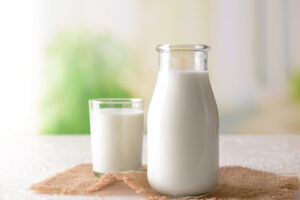Raw Milk – Is it Safe?

Drinking raw milk has become a popular “natural” food trend in the past few years due to rumors of it having certain health benefits. But, what even is raw milk? Is it safe?
There is a lot of misleading information out there about raw milk which can make it confusing to decipher through all of the claims. Let’s break down what raw milk is and bust a few of the myths that are floating around the internet.
When milk is “raw” it means that it has not gone through the process of pasteurization. All milk and most dairy products you can find in a grocery store are made from pasteurized milk. (The FDA allows raw cheese to be sold in the U.S. legally if the cheese has been fermented for 60 days or more because fermentation can kill harmful pathogens.) This means that they have gone through a heating process that kills harmful pathogens: bacteria, viruses, and parasites that can be present in milk. These pathogens have the potential to make you really sick (they can even be deadly!). A long time ago, so many people would regularly get ill from milk, that farmers started pasteurizing it in 1864 as a way to help keep the public safe from these common pathogens. It is an extremely effective process and therefore, pasteurization has saved many people’s lives. The introduction of pasteurization had such a positive impact on public health, that eventually only pasteurized milk was deemed safe and it actually became illegal to sell milk that was not pasteurized (aka raw or unpasteurized milk) in some states in 1987. Today each state has its own laws regarding the sale: in some states sale is legal only on a farm, in others it is illegal regardless of where it is sold, and in others it is legally sold.
One common misconception that leads people to seek out raw milk is the thought that it naturally contains probiotics (beneficial bacteria that can be good for gut health). The assumption is that pasteurized milk does not have probiotics, due to killing them off in the heating process. Unfortunately, the idea that raw milk is a safe source of probiotics is a misleading and dangerous claim. True there are various microorganisms found in raw milk and it is possible that a small amount of these microorganisms are beneficial. However, these bacteria would not be coming from a safe source. Milk is essentially sterile (free of any bacteria, good or bad) before leaving the cow’s udder, but it is the milking process that may contaminate the milk with bacteria. Therefore, the microorganisms found in milk are likely introduced from infected udder tissue, animal fecal matter, etc. Yuck! For example, raw milk advocates cite Bifidobacteria (commonly found in both human and animal GI tracts) as one of the “good bacteria” that can be found in raw milk. This bacteria does not naturally exist in the milk itself like many believe, but it exists in the animal’s fecal matter. So basically, it would not be a good thing to have Bifidobacteria present in your milk as it would be a sign that a large amount of harmful bacteria was also present. It would be an indication of poor farm hygiene and/or the animal’s health and that the milk is not safe to drink.
Another rumor is that people who have lactose intolerance should drink raw milk instead of pasteurized milk because they would be able to tolerate it without having the symptoms of lactose intolerance. Raw milk advocates claim that raw milk contains the enzyme lactase because it is secreted by beneficial bacteria that is present in raw milk. When people are lactose intolerant, it means that they lack this enzyme lactase in their body which is necessary to break down the lactose in the milk. When lactase is absent, it can cause GI symptoms associated with lactose intolerance. These advocates claim that because the beneficial bacteria are killed during pasteurization, regular milk does not have the lactase secreted by the beneficial bacteria. But, as we mentioned before, raw milk does not contain beneficial bacteria from a safe source and is likely contaminated with various harmful pathogens. Also, the secretion of lactase described is caused only by specific bacteria, and there is no guarantee that these specific bacteria would even be present in all raw milk or in specific quantities. Research has shown that the amount of beneficial bacteria present in raw milk is relatively low and therefore would likely not present much of a benefit to those with lactose intolerance.
To make a long story short, drinking raw milk is not safe. It presents a big safety risk because you can become really sick via those nasty pathogens that are likely present. Additionally, since it is illegal to sell, there are really no safety regulations to keep consumers safe. Besides, there are much safer ways to get probiotics into your diet. Things like kimchi, sauerkraut and miso are great sources. So are yogurt and kefir from the grocery store, for example. They are made from pasteurized milk and have specific beneficial bacteria added from a safety-controlled source. If you’re lactose intolerant and looking to enjoy some dairy products, the specific beneficial bacteria safely and purposely added to many yogurts in significant levels (Streptococcus thermophilus and Lactobacillus bulgaricus) have been seen to show benefit towards lactose intolerance GI symptoms (by breaking down that lactase enzyme as we talked about before). These are great (and safe!) options to try out, and that way, you don’t have to take any chances on harmful pathogens making their way into your dairy products!
-Dietitian Katelyn

